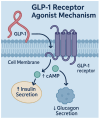A Closer Look at the Dermatological Profile of GLP-1 Agonists
- PMID: 40422559
- PMCID: PMC12110338
- DOI: 10.3390/diseases13050127
A Closer Look at the Dermatological Profile of GLP-1 Agonists
Abstract
Background/objectives: Glucagon-like peptide-1 receptor agonists (GLP-1RAs) are widely used in treating type 2 diabetes and obesity, offering established metabolic and cardiovascular benefits. Emerging evidence suggests these agents also exert direct dermatologic effects. This systematic review categorizes these effects and explores their role in inflammatory skin diseases.
Methods: A comprehensive literature search was performed across EMBASE, PubMed, Web of Science, and Google Scholar for studies published from 2014 to 2025. Inclusion criteria were English-language, peer-reviewed original research involving human subjects that linked GLP-1RAs to dermatologic effects. Animal and in vitro studies were excluded. PRISMA guidelines were followed.
Results: Fifty-one studies met inclusion criteria. Thirty-four reported adverse effects, including hypersensitivity, injection-site reactions, pruritus, urticaria, angioedema, and immune-mediated conditions like bullous pemphigoid. Seventeen studies described beneficial outcomes, such as improvements in psoriasis, reduced hidradenitis suppurativa flares, enhanced wound healing, anti-aging potential, and decreased inflammation. GLP-1RAs showed cytokine modulation in psoriasis, though their role in hidradenitis suppurativa remains uncertain. Cosmetic concerns, such as "Ozempic Face" due to rapid weight loss, were also noted.
Conclusions: GLP-1RAs have a broad spectrum of dermatologic effects, from immunomodulatory benefits to adverse cutaneous reactions. Their impact on inflammatory skin disorders suggests a novel therapeutic avenue. However, adverse reactions and aesthetic changes warrant vigilance. Future research should focus on mechanistic studies, long-term safety, and identifying biomarkers to predict dermatologic responses, ultimately guiding personalized treatment approaches.
Keywords: GLP-1 receptor agonists; dermatological side effects; hidradenitis suppurativa; hypersensitivity reactions; immune modulation; inflammatory skin diseases; injection site reactions; metabolic changes; psoriasis; weight loss.
Conflict of interest statement
The authors declare no conflicts of interest.
Figures





References
-
- Boccardi A., Shubrook J.H. Cutaneous reactions to antidiabetic agents: A narrative review. Diabetology. 2022;3:97–107. doi: 10.3390/diabetology3010008. - DOI
-
- Yao H., Zhang A., Li D., Wu Y., Wang C.Z., Wan J.Y., Yuan C.S. Comparative effectiveness of GLP-1 receptor agonists on glycaemic control, body weight, and lipid profile for type 2 diabetes: Systematic review and network meta-analysis. BMJ. 2024;384:e076410. doi: 10.1136/bmj-2023-076410. - DOI - PMC - PubMed
Publication types
LinkOut - more resources
Full Text Sources
Miscellaneous

